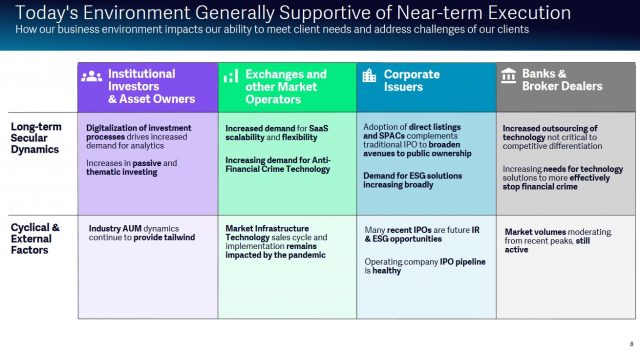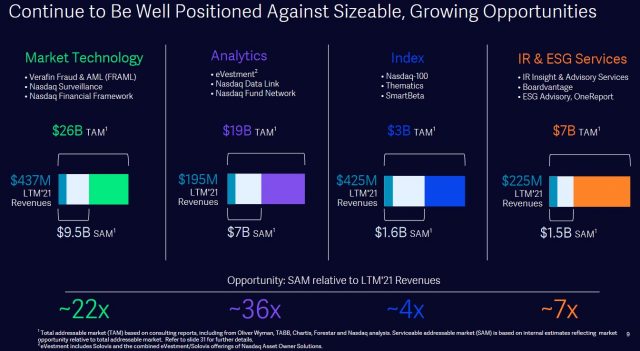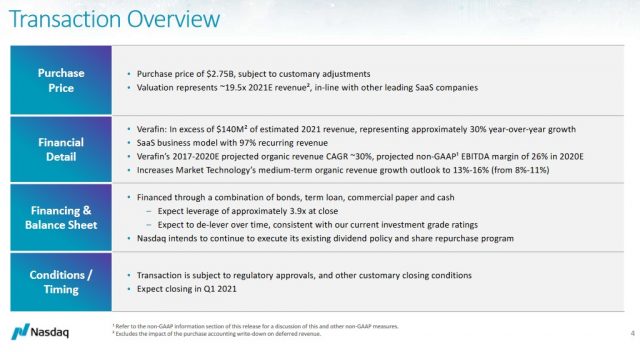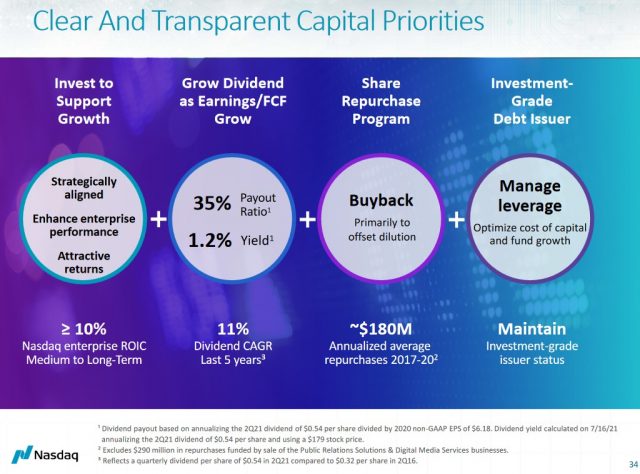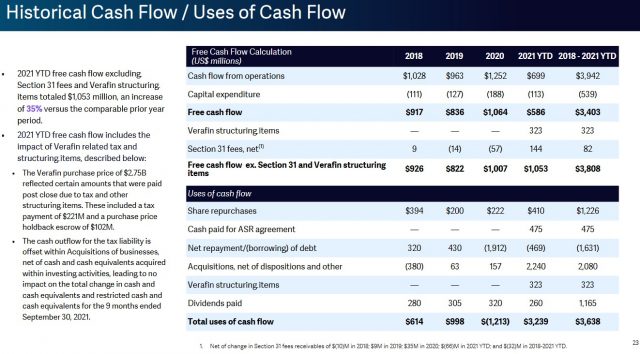Contents
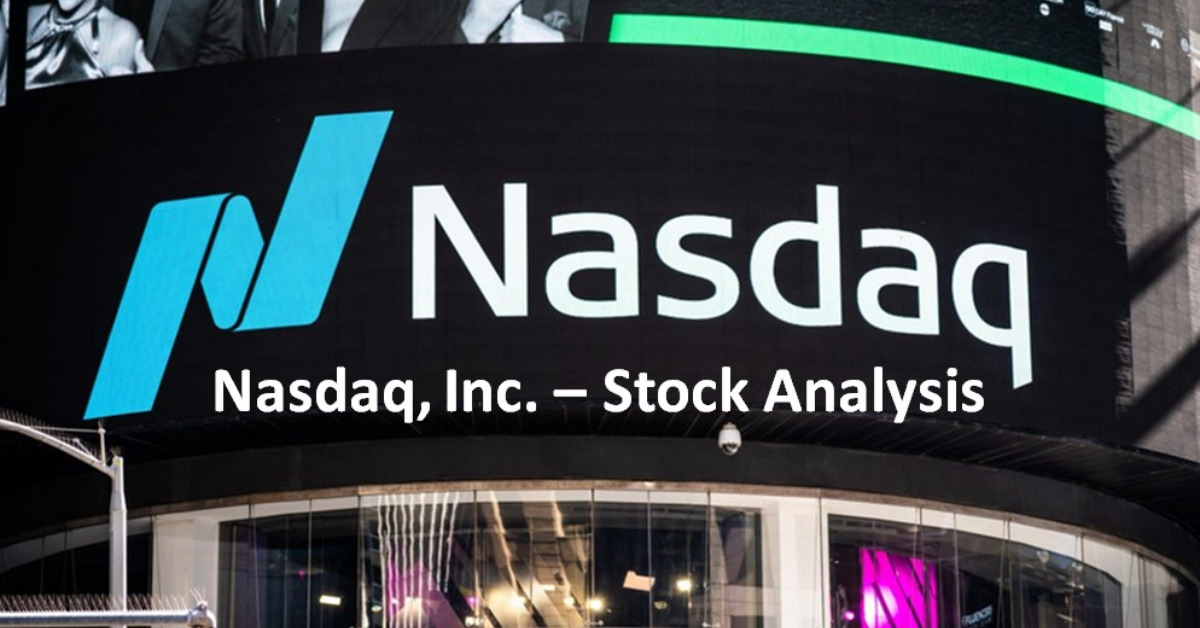
This Nasdaq, Inc. (NDAQ) stock analysis is the second in my series of analyses of Financial Data & Stock Exchanges industry participants. My FactSet Research Systems Inc. (FDS) analysis is the first article within this series.
As indicated in my FDS post, I view the Financial Data & Stock Exchanges industry as an attractive industry in which to invest for the long term. I currently have exposure to the following in retirement accounts, for which I do not disclose details, and/or in the FFJ Portfolio:
- S&P Global (SPGI) - guest post at Dividend Power
- Moody's (MCO)
- CME Group (CME) - guest post at Dividend Power
- Intercontinental Exchange (ICE)
These industry participants will release earnings on the following dates and I intend to review each company shortly following their respective earnings release.
- FactSet Research Systems Inc. (FDS) - released September 28
- Nasdaq, Inc. (NDAQ) - released October 20
- MSCI Inc. (MSCI) - October 26
- S&P Global Inc. (SPGI) - October 26
- Morningstar, Inc. (MORN) - October 27
- CME Group Inc. (CME) - October 27
- Intercontinental Exchange, Inc. (ICE) - October 28
- Moody's Corporation (MCO) - October 28
- CBOE Global Markets, Inc. (CBOE) - October 29
- TMX Group Limited (X.to) - November 8
Value Line, Inc. (VALU) released its Q1 2022 results for the quarter ending July 31 on September 13, 2021. This is a small-cap company ($0.31B market cap). I do not invest in small-cap companies, and therefore, do not intend to review it.
Nasdaq - Stock Analysis - Industry Overview
NDAQ's ranking by market cap relative to the other major North American stock exchanges places it below CME and ICE but well above CBO and TMX.to.
The industry is characterized by intense competition which includes other exchange operators, operators of non-exchange trading systems and banks and brokerages that operate their own internal trading pools and platforms.
NDAQ has 4 business segments (see comments in the Business Overview section). The industry dynamics in which each business segment competes differ to some degree but, in general, the competitive environment in each is intense. Many of NDAQ's competitors have significant strengths and resources and have financials that are superior to those of NDAQ.
Further commentary about the industry and how industry participants are expanding into adjacent lines of business is found in my recent FactSet Research post.
Nasdaq - Stock Analysis - Business Overview
NDAQ was founded in 1971 as a wholly-owned subsidiary of FINRA. Beginning in 2000, FINRA restructured and broadened ownership in NDAQ by selling shares to FINRA members, investment companies and issuers listed on The Nasdaq Stock Market. In connection with this restructuring, FINRA fully divested its ownership in 2006, and The Nasdaq Stock Market became an independent registered national securities exchange in 2007.
In February 2008, Nasdaq and OMX AB combined their businesses and the corporate name changed to The NASDAQ OMX Group, Inc. This transformational combination resulted in the expansion from a U.S.-based exchange operator to a global exchange company offering technology that powers domestic exchanges and markets as well as many other marketplaces globally.
It operated as the NASDAQ OMX Group until the business was rebranded as Nasdaq, Inc. in 2015. This chart shows the company's historical evolution.

Source: NDAQ FY2020 10-K
As a global technology company, it serves the capital markets and other industries through a diverse offering of data, analytics, software and services that enable clients to optimize and execute their business vision.
As noted above, NDAQ manages, operates and provides products and services in four business segments:
- Market Services;
- Corporate Platforms (formerly Corporate Services);
- Investment Intelligence (formerly Information Services); and
- Market Technology.
Part 1 of NDAQ's FY2020 10-K has a comprehensive overview of the company's history, business strategy, competitive landscape, risk factors, and more. This section of the 10-K includes an overview of the competitive landscape in each of NASDAQ's four business segments.
Transformation
In 2017, NDAQ completed a review of its strategy for long-term growth. Key macroeconomic, regulatory and technology trends were examined, the competitive landscape was assessed and consultation was held with clients about short and long-term trends in their businesses. Based on the key trends identified, NDAQ has undertaken a business transformation and significant progress has been made on repositioning the business.
Following the announcement of its decision to strategically reposition itself, NDAQ is now targeting a double-digit total shareholder return.
Verafin Acquisition
On February 11, 2021, NDAQ's acquisition of Verafin for $2.75B was completed; Verafin is an industry pioneer in anti-financial crime management solutions.
The acquisition combines Verafin's comprehensive suite of anti-financial crime management products with NDAQ's reach and established regulatory technology leadership to create a global SaaS leader in the fight against financial crime.
While the acquisition raised leverage, NDAQ has a track record of deleveraging following major acquisitions.

Source: NDAQ - Verafin Acquisition Presentation - November 19, 2020
Sale of US Fixed Income Business
Following a strategic review, NDAQ announced on February 2, 2021 its decision to sell its US Fixed Income business to Tradeweb Markets Inc. (TW), a leading global operator of electronic marketplaces for rates, credit, equities and money markets. This sale was completed in June 2021.
Proceeds from this sale, available tax benefits and other sources of cash were used to repurchase shares to offset dilution to non-GAAP EPS. The proceeds from the sale, the remaining tax benefits related to the 2013 purchase of this business, and the working and clearing capital to be released upon closing of the transaction amounted to ~$0.7B.
NDAQ's Board authorized an additional $1B increase to the share repurchase program to facilitate these repurchases.
When this sale was announced, NDAQ indicated it did not intend to increase its leverage as a result of the share repurchases related to this transaction. The plan is to continue with the previously announced de-leveraging plans following the closing of the Verafin acquisition.
Capital Priorities
NDAQ invests to support growth and has set a 10%+ Medium to Long-Term Return on Invested Capital (ROIC). In FY2019 and FY2020, NDAQ achieved slightly more than 9%.
Other capital priorities include a conservative dividend growth target and share buybacks will be primarily to offset dilution from shares issued as part of compensation packages.
Leverage will also be managed to maintain investment-grade credit ratings.
Nasdaq - Stock Analysis - Financials
Q3 and YTD2021 Results
On October 20, 2021, NDAQ released Q3 and YTD2021 results with the accompanying Earnings presentation.
In Q3, NDAQ delivered $0.838B in revenue less transaction-based expenses for a $0.123B or 17% increase from Q3 2020. Growth was largely driven by 13% organic revenue growth in the Solutions segment, 14% organic growth in the Market Services business and contributions from the Verafin acquisition.
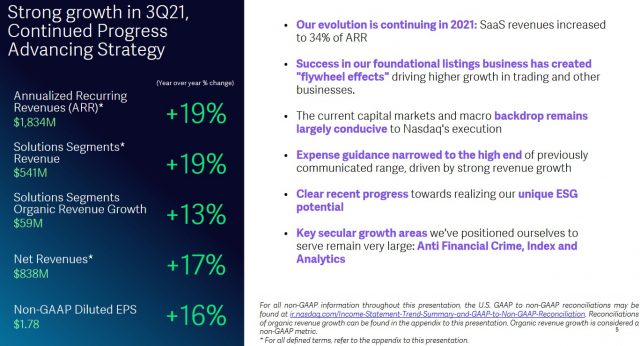
Source: NDAQ Q3 2021 Earnings Presentation - October 20, 2021
Notable progress continues to be made across key secular growth opportunities. Annualized recurring revenue (ARR) of $1.834B is an increase of 19% compared to Q3 2020.
Within its recurring revenue businesses, NDAQ is seeing some of the best performances from SaaS-based solutions. Anti-financial crime technology is showing particularly strong results with revenues increasing 16%; this growth excludes the impact of Verafin. Verafin will begin to be included in NDAQ's organic growth calculations next year.
NDAQ's investment in its intelligence business drove the 13% increase in the analytics revenue.
YTD organic revenue growth of 15% across the Solutions segments continues to meet or exceed the medium-term 6% - 9% annualized growth target set following the Verafin acquisition.
Because NDAQ is growing its SaaS revenues more quickly than the 19% YoY ARR, the total percentage of ARR that is being generated from the SaaS businesses rose to 34% at the end of Q3. This is up from 28% in Q3 2020 and is trending toward the medium-term objective of 40% - 50% by 2025.
Key Financial Ratios and Volume Statistics
Key financial ratios and daily/monthly volume statistics are accessible here. Looking at the Quarterly Volumes, Market Share and Listings for Q1 2019 - Q3 2021, we see NDAQ is benefiting from higher US option trading volumes. These volumes, however, are below Q1 highs but still well above pre-pandemic levels (top of page 2 of 2). New discount brokerage services and changes in investor behaviour, however, will likely be a tailwind for NDAQ’s equity and option exchanges even as it loses market share to new entrants.
On the Q3 earnings call, management indicated 'the U.S. has experienced the best new issuance in the past two decades. NDAQ continues to demonstrate strength with a 75% win rate for IPOs in the quarter and a 72% win rate year-to-date.' We see from the September Quarterly Volumes, Market Share and Listings report that the number of companies listed on the NDAQ has grown from 2671 in Q1 2019 to 3560 in Q3 2021.
Free Cash Flow
The following provides a high-level overview of NDAQ's historical cash flow and uses of cash flow.
Nasdaq - Stock Analysis - Credit Ratings
NDAQ
NDAQ's senior unsecured long-term debt is currently rated as follows:
- Moody's: Baa2 with a stable outlook
- S&P Global: BBB with a stable outlook
Both ratings are the middle tier of the lower-medium investment-grade category. These ratings define NDAQ as having an ADEQUATE capacity to meet its financial commitments. However, adverse economic conditions or changing circumstances are more likely to lead to NDAQ having a weakened capacity to meet its financial commitments.
NDAQ has total debt obligations of ~$5.9B but the maturity dates of its debt are well distributed.
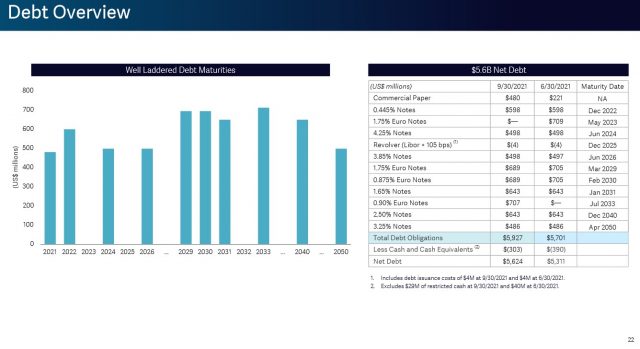
Source: NDAQ Q3 2021 Earnings Presentation - October 20, 2021
In comparison, the other major US stock exchanges have superior credit ratings.
ICE
Moody's downgraded ICE's senior unsecured long-term debt credit rating from A2 to A3 following the Ellie Mae acquisition; the revised rating is the lowest tier of the upper-medium investment-grade category.
S&P Global also lowered ICE’s long-term credit rating to BBB+ which is one notch lower than Moody’s rating. It is the top tier of the lower-medium investment-grade category.
Moody’s rating defines ICE as having a STRONG capacity to meet its financial commitments. It is, however, somewhat more susceptible to the adverse effects of changes in circumstances and economic conditions than obligors in higher-rated categories.
S&P Global's rating defines ICE as having an ADEQUATE capacity to meet its financial commitments. It is, however, more susceptible to the adverse effects of changes in circumstances and economic conditions than obligors in higher-rated categories.
The outlook from both rating agencies is stable.
CME
CME's senior unsecured long-term debt is currently rated:
- Moody's: Aa3 with a stable outlook
- S&P Global: AA- with a stable outlook
Both ratings are the lowest tier of the high-grade investment-grade category. These ratings define CME as having a VERY STRONG capacity to meet its financial commitments. It differs from the highest-rated obligors only to a small degree.
CBOE
CBOE's senior unsecured long-term debt is currently rated:
- Moody's: A3 with a stable outlook
- S&P Global: A- with a stable outlook
Both ratings are the lowest tier of the upper-medium investment-grade category. These ratings define CBOE as having a STRONG capacity to meet its financial commitments. It is, however, somewhat more susceptible to the adverse effects of changes in circumstances and economic conditions than obligors in higher-rated categories.
TMX
TMX's debt is only rated by Morningstar DBRS. Its issuer rating is A (high) and the outlook is stable.
DBRS defines companies with this rating as having 'Good financial strength. The issuer’s capacity for the payment of contractual obligations is substantial, but of lesser financial strength than AA. Companies with this rating may be vulnerable to adverse business and economic conditions, but qualifying negative factors are considered manageable.'
Dividend and Dividend Yield
NDAQ's dividend history is accessible here. The next $0.54 quarterly dividend is payable on December 17, 2021 to shareholders of record at the close of business on December 3, 2021.
With shares currently trading at ~$199, the $0.54 quarterly dividend yields ~1.1%.
On June 16, 2021, NDAQ's board of directors authorized an increase to the share repurchase program to an aggregate authorized amount of $1.5B.
During Q3, NDAQ repurchased $0.475B of shares in its common stock and repurchased an aggregate of $0.885B during the 3 quarters of FY2021. This reflects the impact of the Accelerated Share Repurchase (ASR) program. As of September 30, 2021, there was $0.984B remaining under the board authorized share repurchase program.
One of NDAQ's capital priorities is to repurchase shares to help offset dilution. This is borne out by the average shares outstanding (in millions) in FY2011 - FY2020: 180, 173, 171, 173, 171, 169, 170, 168, 167, and 167. The number outstanding rose to 167.9 in Q3 despite the share repurchases noted above.
Share repurchases are primarily funded from existing cash balances. These purchases may be made from time to time at prevailing market prices in open market purchases, privately negotiated transactions, block purchase techniques or otherwise, as determined by the management. The share repurchase program may be suspended, modified or discontinued at any time and there is no defined expiration date.
Nasdaq - Stock Analysis - Valuation
NDAQ has generated $5.63 in YTD adjusted diluted EPS ($5.53 in GAAP earnings).
FY2021 non-GAAP operating expense guidance has been narrowed to $1.605B - $1.62B from the previous $1.59B - $1.62B range. Using YTD results and this revised range, I envision FY2021 adjusted diluted EPS will be ~$7.35 - $7.45. Shares are currently trading at ~$199 thus giving me a forward diluted PE range of ~26.7 - ~27.
Broker guidance derived from the two online trading platforms I use is:
- FY2021 - 14 brokers - mean of $7.32 and low/high of $6.91 - $7.46. Using the mean estimate and the current share price, the forward adjusted diluted PE is ~27.2 and ~26.7 if I use $7.46.
- FY2022 - 14 brokers - mean of $7.56 and low/high of $7.27 - $8.19. Using the mean estimate and the current share price, the forward adjusted diluted PE is ~26.3 and ~24.3 if I use $8.19.
- FY2023 - 12 brokers - mean of $8.23 and low/high of $7.56 - $9.08. Using the mean estimate and the current share price, the forward adjusted diluted PE is ~24.2 and ~22 if I use $9.08.
GAAP EPS for FY2021 will likely come in within $7.20 - $7.30. On this basis, the forward diluted PE is ~27.3 - ~27.6 versus FY2011 - FY2020 diluted PE levels of 10.30, 12.25, 20.52, 17.70, 27.31, 23.63, 49.57, 18.25, 33.89, and 24.31.
I am reluctant to place much reliance on valuations beyond FY2022 since much can happen over a 2-year timeframe to change estimates. Furthermore, there is a $1.74 disparity in FY2023 estimates from the 11 brokers who have provided input.
Nasdaq - Stock Analysis - Final Thoughts
Since the dividend yield is low it is doubly important to acquire shares when attractively valued. Failure to do so exposes investors to a greater risk of sub-standard investment returns. I am not, therefore, initiating a position at the current valuation.
Stay safe. Stay focused.
I wish you much success on your journey to financial freedom!
Note: Please send any feedback, corrections, or questions to [email protected].
Disclosure: I am long SPGI, MCO, CME, and ICE. I do not currently hold a position in NDAQ and do not intend to initiate a position within the next 72 hours.
Disclaimer: I do not know your circumstances and do not provide individualized advice or recommendations. I encourage you to make investment decisions by conducting your own research and due diligence. Consult your financial advisor about your specific situation.
I wrote this article myself and it expresses my own opinions. I do not receive compensation for it and have no business relationship with any company mentioned in this article.


